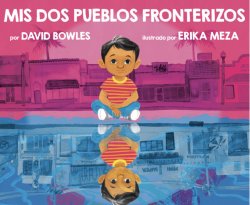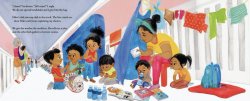
Review of Mis Dos Pueblos Fronterizos / My Two Border Towns by David Bowles
Reviewed by Amy Reed-Sandoval
When children talk about migration and displacement, they generally speak and inquire
about people. Why are some people forced to leave their homes—or why was I forced to
leave my home? Why won’t other countries let them in—or why won’t other countries let
my family and me in? What does it feel like to live in a shelter, or in a refugee camp, or on a
bridge between two countries—or why must my family live this way, while others do not?
This is, of course, strikingly different from the way that many recognized pundits and
politicians talk about the so-called “immigration debate.” The children with whom I have
had the privilege of engaging in philosophical discussions about the ethics of borders have
never asked me whether borders could ever be justified under ideal conditions, or who
should get to “count” as a refugee (which is not to deny the importance of these
philosophical questions). Rather, they want to explore difficult ethical challenges about
migration through discussion of real migrants with real faces, stories, and names who are
embedded in real, named communities and crossing real, named borders. The question of
what migration feels like from different angles—the question of what it actually is—tends to
be, at least in my experience, the phenomenological starting point for many children
inquiring about migration ethics.
Fortunately, the next time I facilitate a pre-college philosophy session about migration and
borders, I will be able to use for that purpose the recent storybook Mis Dos Pueblos
Fronterizos (available in Spanish under this title, and also in English with the title My Two
Border Towns), authored by David Bowles and gorgeously illustrated by Erika Meza. The
book shows how philosophical questions about migration can be inspired by, and embedded
in, communities and characters that children can read, imagine, and care about. Mis Dos
Pueblos Fronterizos tells the story of the journey of a young boy, Asere, and his dad—both
of whom live in the Mexico-U.S. borderlands with the rest of their family—across the
Mexico-U.S. border for a day trip to a Mexican border town where they do the things they usually do on this bi-monthly, Saturday trip. They have breakfast at their favorite restaurant,
where they sip café de olla and hot chocolate, then visit an uncle’s jewellery shop where
Asere plays soccer with his cousins while the grownups talk about politics. They enjoy sweet
paletas, buy groceries, and pick up various medicines at a pharmacy.

After an enjoyable morning of errands, food, and family visits comes what Asere’s father
describes as the most important part of the trip: it is time for them to “take care of our
people.” Asere is prepared for the ensuing event—he has a backpack filled with comic
books, pencils, notebooks, and video game cassettes, and he adds to his backpack additional
items that they bought throughout the day. Then, Asere and his father drive to the Mexico-
U.S. border (still on the Mexican “side”) where they approach families of Caribbean and
Central American migrants who have sought shelter inside the pedestrian bridge that
countless people have used to cross and recross the Mexico-U.S. border. These families,
however, are described by Asere’s father, in conversation with Asere, as “refugees” who are
“stuck between two countries.” Neither the United States nor Mexico, the father explains,
wants to take responsibility for letting these individuals and families in despite their
obviously desperate circumstances.
Asere spots one of his friends, Elder, from the community of migrants currently sheltered on
the bridge, and they begin to play. Asere and his father then distribute needed medicines,
toys, and educational materials, and everyone catches up with one another. Later, when
Asere and his father drive home, he says that he wishes that Elder could come to his house
to play. His father replies that it is unfair of the United States to deny Elder and other
migrant people the right to enter when the country is perfectly capable of doing so. Finally,
when they take out their passports to return to the United States, the boy seems to reflect
on the freedom those documents give them.

Mis Dos Pueblos Fronterizos is not only a beautifully-illustrated book and a rich and an
engaging read; it is also an excellent tool with which to inspire philosophical conversations
about immigration with young people. Children who do not live in borderlands contexts may
raise questions about what it is like to identify with two pueblos located on different styles
of the border. Meanwhile, borderlands children, like my own El Paso-born four-year-old and
the children with whom I worked in the Philosophy for Children in the Borderlands program,
will surely identify with the Saturday border-crossing experience of the boy and his father.
This, in turn, can raise broad philosophical questions about transborder identities, familial
connections, and lives.
Young readers may also be drawn, in different ways, to the friendship between Asere and
Elder. What does it feel like to be separated from a friend by a giant border wall? Is it fair for
friends to be kept apart? Why can’t Asere and his father simply let Elder and others into the
United States on their own—that is, why aren’t they somehow empowered to do this?
The book also inspires questions about fairness and migration ethics. Is it fair for countries
to keep people out? Why, exactly, is this happening today? What can people born in
comparatively wealthy and privileged countries like the United States do to help those who
are excluded?
Mis Dos Pueblos Fronterizos deals sensitively, and artfully, with one of the major
humanitarian crises of our time. And it does so in a way with which children can
identify—emphasizing play, friendships, familial customs, and concrete ways in which
children and adults can help others. The book emphasizes what young philosophers already
know: that migrants are real people, living in real places, and embedded in real human
relationships that are philosophically perplexing and deserving of collaborative analysis.
